What is Movement Marketing? Definition & Examples

Today, anything traditional gets shifted quickly, giving the place under the sun to new, promising, and proactive things. It is absolutely the same with marketing, where traditional tactics often face criticism and fail to adapt to modern users’ needs.
Movement marketing which we’ll cover today, is a very dynamic, yet not viral approach in today’s market. It advocates moving away from conventional sales-oriented tactics and, instead, aligning brand philosophy and vision with today’s movements. This approach aims to inspire change and ignite a sense of purpose among consumers.
Today, movement marketing will be at the center of our discussion. We’ll explore its core principles, probably tap into its historical roots, examine how it became a really potent strategy and why you should know about it.
Understanding movement marketing
To start with the basics, movement marketing is a tactic that shifts in the way brands engage with their audiences.
Unlike traditional strategies that push the audience to purchase products or services, movement marketing focuses on championing a cause or purpose that resonates deeply with consumers. In simpler words, movement marketing aims to unite people around a shared vision, inspiring them to become active participants in a broader social or cultural movement.
Marketing movement has a strong social impact. It is often associated with a potent emphasis on values, beliefs, and social impact. Accordingly, brands that build their strategy around movement marketing are often known as game changers, as they strive to make a meaningful difference in society, leveraging their influence to drive positive change.
Historical perspective
Movement marketing may be associated with something modern that brings the wind of changes. However, its roots or at least the same concepts can be seen in various marketing tactics from the past.
Probably one of the most notable examples is Marlboro’s health awareness campaign. It was one of the leaders in the anti-smoking campaigns of the mid-20th century, promoting health awareness which is completely opposite to Marlboro’s products. However, associating themselves with a broader movement towards healthier living, Marlboro and other brands sought to position themselves as socially responsible.
Another notable example would be the women's suffrage movement and how cosmetics played a huge role in it. During the suffrage movement, individuals like Elizabeth Arden, Sarah Bernhardt, Helena Rubinstein, and many others made a huge impact on promoting women’s rights, self-identity, and freedom.
Along with the movement, some cosmetic companies aligned with the cause of women's rights. They marketed their products as a way for women to assert their independence and self-expression.
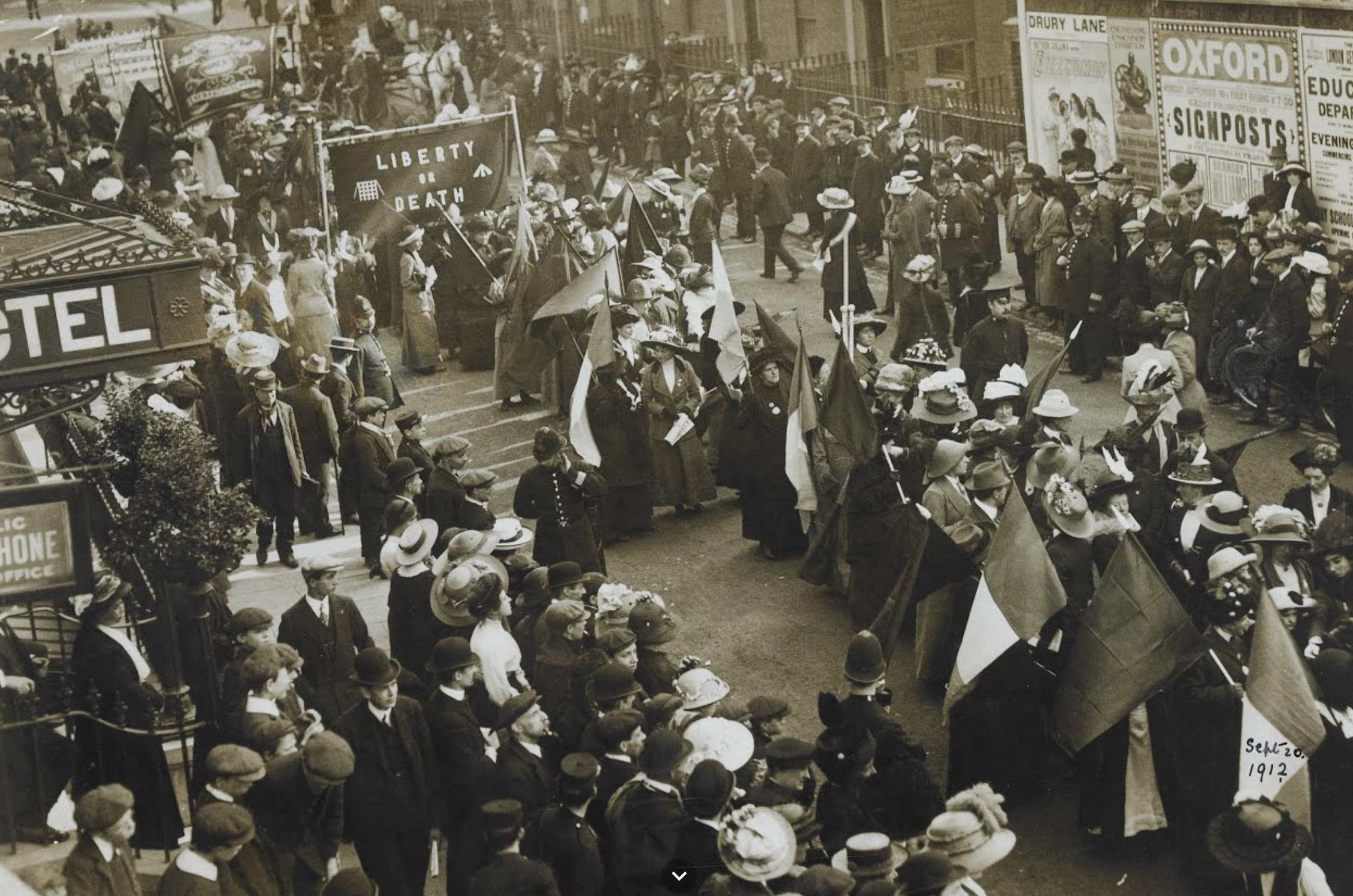
Mentioned Helena Rubinstein, for example, advertised her makeup as a tool for women to enhance their confidence and self-esteem. Sarah Bernhardt, in turn, was the first actress to not only wear red lipstick but apply it in public which was a giant step towards women being more visible and empowered in public.
With examples, movement marketing’s ideology becomes clearer. So, let’s face the inevitable – it is an absolutely fantastic strategy with a noble vision, deep roots, and significance in today's marketing landscape.
The key elements of movement marketing
It seems pretty obvious that movement marketing can be a big thing nowadays. So, let’s look at it from the brands’ perspective. What’s the perfect recipe to create a successful movement marketing strategy? What are the essential components? Let’s find out!
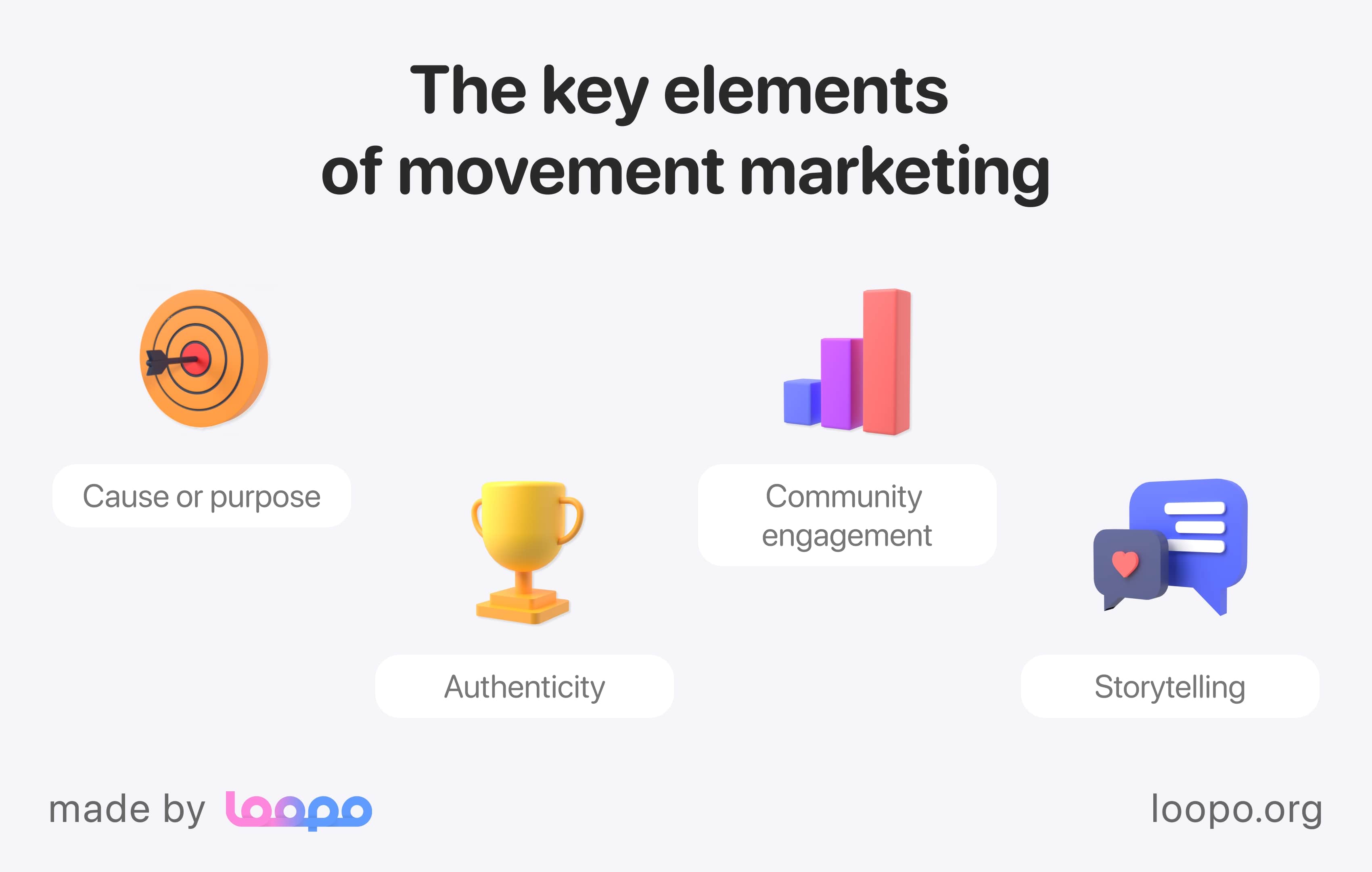
Cause or purpose
As we already figured out, at the heart of movement marketing lies a compelling cause or purpose. This element is the North Star, the cornerstone because it defines the entire campaign.
Brands that successfully engage in marketing movement recognize the importance of standing for something beyond profits. To apply a strategy, you will need to identify a global cause or issue that, at least partially, aligns with your company’s values and resonates with the target audience.
It may sound selfish, but from the brand’s perspective, the cause should align with the philosophy and mission you advocate. Thus, you will need a well-chosen cause. Why?
It serves as the rallying point for consumers, allowing them to connect emotionally with the brand. Apparently, there are numerous aspects that need attention: environmental sustainability, social justice, well-being, civil rights, and health.
After all, the cause you choose should be authentic, relevant, and capable of inspiring action. Brands that genuinely commit to their chosen cause build credibility and trust with their audience, ultimately leading to stronger brand loyalty while also attracting attention to the cause.
Authenticity
Needless to say, authenticity is key to creating a reasonable movement marketing. Moreover, there is a solid moral aspect to this. To put it simply, you should never come up with a cause to use it as a sales booster only. Instead, it must be authentic and work shoulder-to-shoulder with your brand.
People today are discerning and can quickly spot inauthentic attempts to jump on the bandwagon of a popular cause. Many of us saw such lame examples. Coffee shops that fight ocean pollution but use plastic bags to deliver food, clothing brands that ‘fight’ animal extermination on one hand and produce fur clothes on the other.
Thus, brands must demonstrate a genuine commitment to the cause they are championing. And this, in fact, involves a lot. Apart from marketing campaigns, you should demonstrate sustainable business practices, ethical sourcing, case studies, or donations, at the very least.
So, what’s with authenticity? It is vital. With it in place, people feel that the brand is not just exploiting a cause for profit but is genuinely invested in making a positive impact. Authenticity builds credibility and trust, two vital factors in the success of a movement marketing campaign.
Community engagement
Being another important aspect of successful movement marketing, community engagement, is what can make the movement viral. Brands that excel in movement marketing often build or tap into existing communities that share their values and passion for the cause. These communities provide a platform for like-minded individuals to connect, share stories, and support the cause together.
Community engagement can take various forms. Some companies organize forums and social media groups, and some prefer gatherings and other offline events. Logically, it creates a space for consumers to express their views, experiences, and aspirations related to the movement. Moreover, with the right approach, you can empower consumers to become advocates for the cause.
Storytelling
To communicate the essence of the cause and the journey towards it, companies use storytelling. Traditionally, people are good at understanding stories and projecting their experiences through themselves. Moreover, stories can evoke emotions, spark discussions, and make the cause relatable and memorable. So, to create a potent storytelling element in your movement marketing strategy, you can use several aspects.
On the one hand, you can use human stories or user-generated ones. They bring personalization and usually highlight how the cause has impacted individuals' lives.
On the other hand, you can also communicate the brand’s journey through a story. In this regard, you can tell about the commitment, challenges, and a lot more you had on your path.
Top 4 examples of movement marketing
Luckily for us, examples are endless as a big part of humanity recognizes how many issues it has. However, let’s not list movement marketing examples kind of out of context. Instead, let’s talk about four interesting ones, which we will align with the key elements we talked about earlier. This way, each example will cover one of the aspects, namely cause, authenticity, community engagement, and storytelling.
Cause or purpose: Ben & Jerry’s
As we already know, choosing the cause can be challenging. In this regard, Ben & Jerry’s dispelled this myth, choosing numerous causes and contributing to them all. They increase awareness, making people associate their company not only with ice cream but also with good deeds.
So, Ben & Jerry’s company is one of the best examples. Instead of choosing a single cause, the company has shown enough strength and commitment to support a dozen initiatives. Their Values page starts with the “ice cream can change the world” phrase, and the list of initiatives they support makes it count!
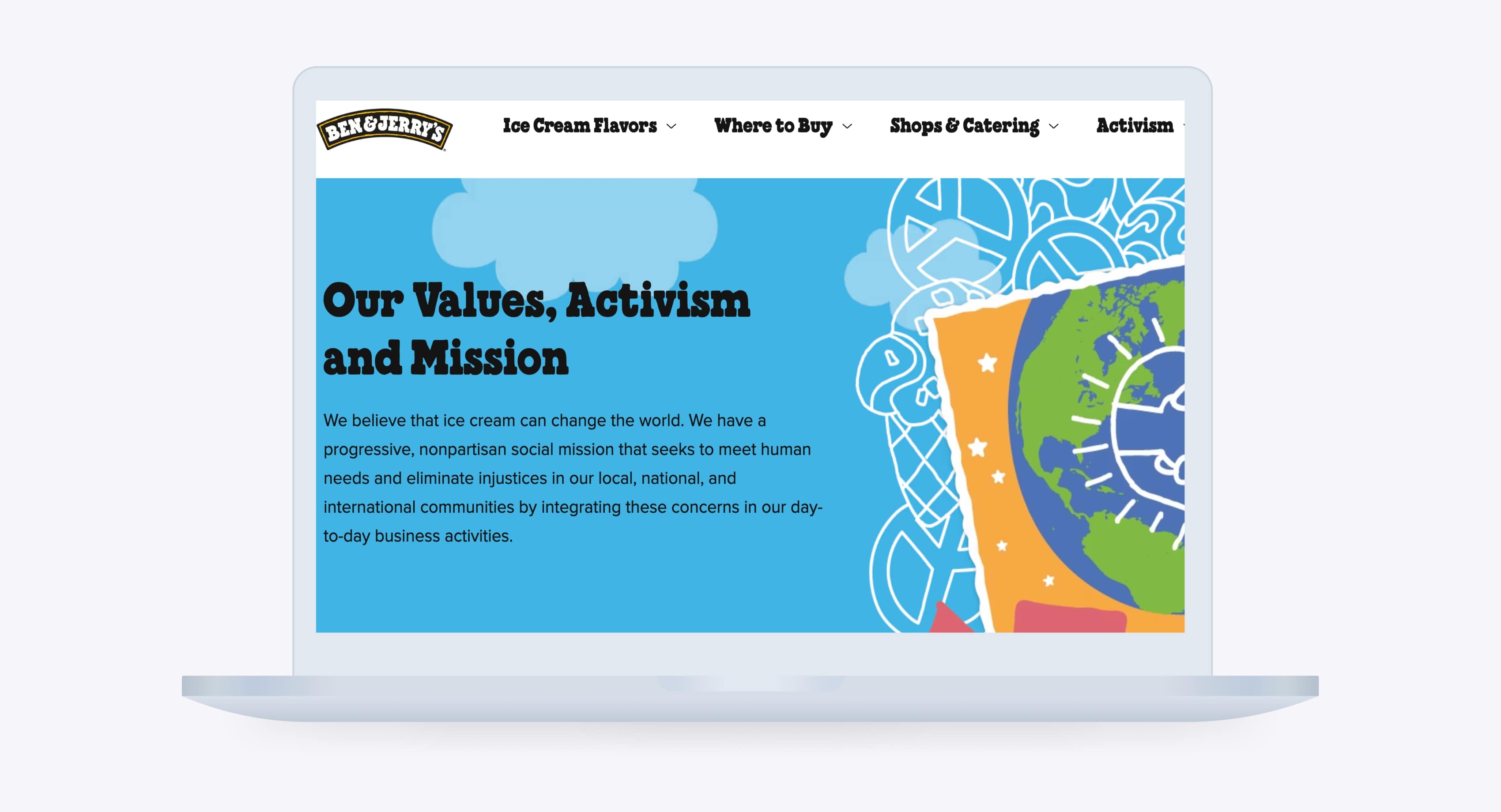
As of today, their values and supported initiatives include racial justice, human rights, fair trade, climate impact, non-GMO standards, and more! After all, the company exploits its popularity to attract people’s attention to important matters, and it deserves respect.
Authencity: Patagonia
Authenticity is abstract and changes with different people’s perspectives. Just as brands need to demonstrate their commitment to the cause, we need to demonstrate examples of movement marketing to our readers. So, speaking of authenticity, the clothing brand Patagonia has one of the greatest initiatives.
Patagonia produces outdoor clothing and equipment. It is a world-known brand popular for its superior quality clothes and gear. Their initiative is called Worn Wear and focuses on reducing clothes consumption by reselling and repairing used goods.
So, what did they do, apart from recognizing the cause? The authenticity, in this matter, is in utility or practicality. The Worn Wear initiative consists of 3 simple steps. It allows people to gather eligible gear and clothing, send it directly to the seller, namely Patagonia itself, and get credits. They, in turn, can be used to purchase new items in-store.
Think about it: after all, it’s a win-win situation for everyone!
Community engagement: Nike
Sports unite people, that’s a solid fact no one can barely doubt. Hence, sports clothing or equipment companies have great potential for movement marketing.
In terms of community engagement, it's hard to omit Nike with its Move To Zero initiative. It comprises several aspects aiming at recycling plastic and textiles, reusing old and used shoes or clothing, etc.
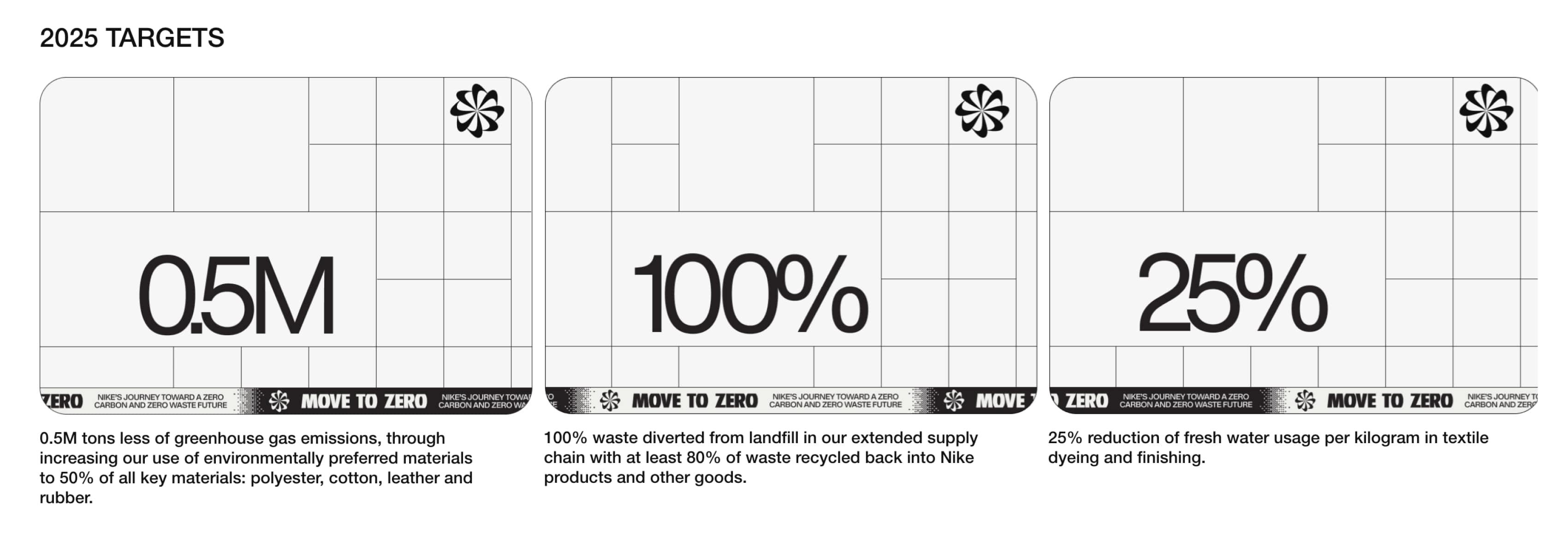
To deliver results and build a community around the cause, Nike offers a lot. Some of the benefits are free shipping options, exclusive clothes styles, and invitations to workshops and events. Moreover, they also offer special offers and promos, training tips, and personalized workouts.
The benefits Nike provides can greatly unite people around the Move To Zero initiative. After all, people are there not only for profit but for the idea, while benefits are just simple motivational steps to get started and join the community.
Storytelling: Dove
Powerful narratives can galvanize people, creating a sense of purpose and motivating them to join the movement. So, traditionally, here is a solid example of storytelling in movement marketing.
Everybody knows a personal care brand called Dove owned by Unilever. Their Real Beauty initiative is one such good example.
The world can be a cruel place, especially for people with imperfections, special needs, and unconventional appearances. Essentially, Real Beauty initiative aims to challenge conventional beauty standards by featuring real women’s stories about their problems, shapes, imperfections, and backgrounds in their advertising. With storytelling, Dove managed to increase awareness about this topic and spark motivation in people to start telling their stories of accepting themselves and supporting others.

After all, the campaign sparked discussions about body image, self-esteem, and beauty ideals, aligning Dove with the movement for greater inclusivity and self-acceptance.
Measuring success in movement marketing
From the business’ point of view, social impact and changes matter, of course. But what also matters is the impact on the business itself. Thus, the success of your movement marketing tactic must be measured using certain metrics.
Measuring the effectiveness of a movement marketing campaign not only provides insights into its performance but also helps brands refine their strategies and demonstrate accountability to stakeholders. But if you wonder where to start and which metrics to follow, here are a few checkpoints that will greatly reflect the performance of your campaign.
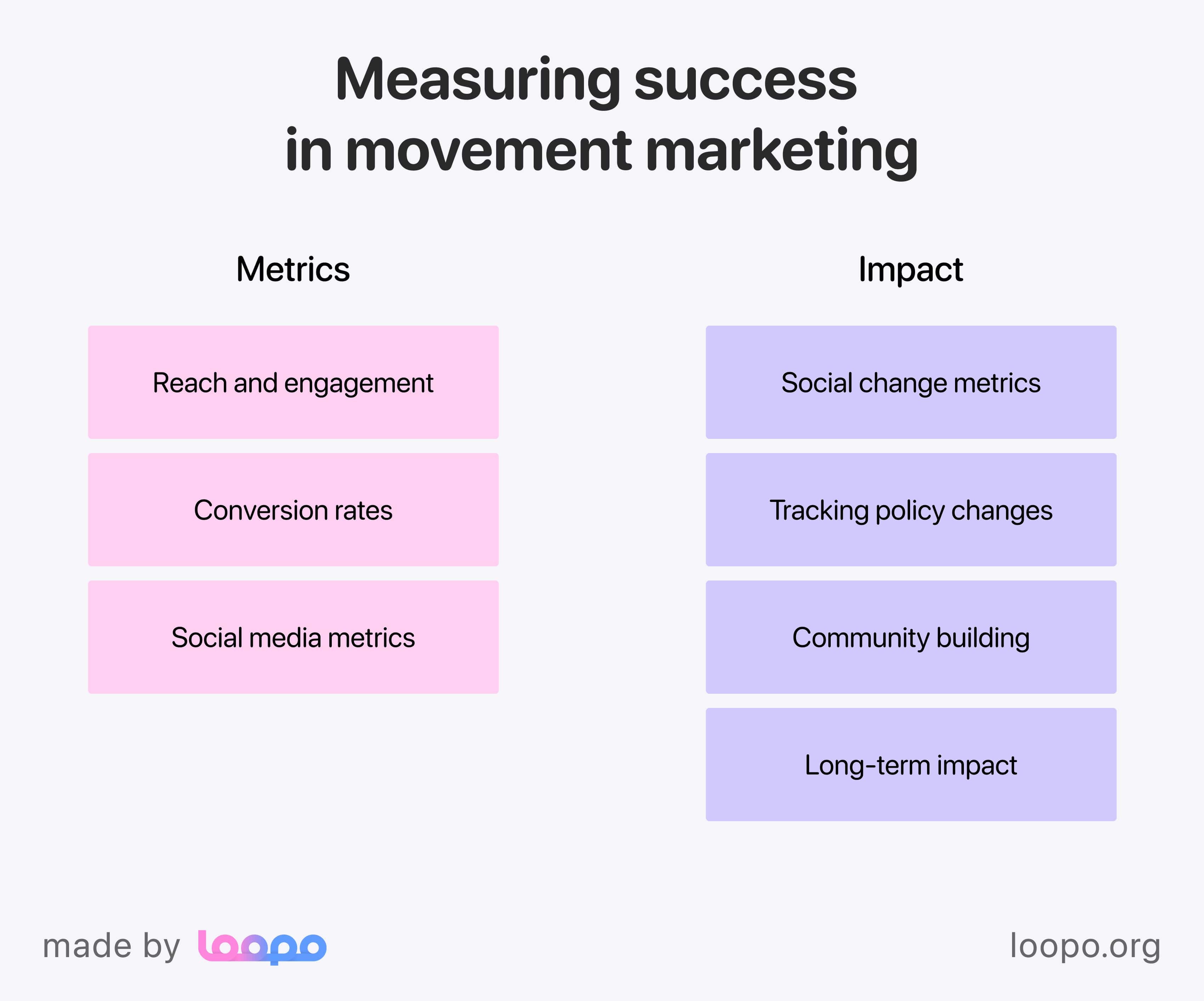
Metrics
Movement marketing campaigns should be assessed using a combination of quantitative and qualitative metrics.
Reach and engagement
To measure the campaign's reach, namely how many people really know about your initiative, you can use metrics like website traffic, social media impressions, and the number of shares and comments. On the other hand, engagement metrics, such as likes, shares, and comments, indicate how well the audience is connecting with the content.
Conversion rates
Analyze how many individuals took the desired actions, whether it's signing a petition, making a donation, or purchasing a product. Conversion rates help gauge the campaign's ability to mobilize support.
Social media metrics
Evaluate the growth of social media followers, the number of reposts, mentions, and the sentiment of online conversations related to the campaign. These metrics reflect the campaign's impact on social platforms. Luckily, many of today’s social media platforms provide a possibility to track those metrics.
Surveys and feedback
Gather feedback from the audience through surveys or comments to understand their perceptions, emotional connections, and motivations regarding the campaign. Qualitative data, in this regard, can be as valuable as quantitative data.
Impact
Beyond the numbers, measuring the real-world impact of a movement marketing campaign is also important. Here are a few ideas on how to do so.
Social change metrics
With their help, you can learn how your marketing movement contributed to the cause it supports. For instance, you can hire or cooperate with people who have expertise in certain areas. With their help, you can learn how your initiative impacted the aspects you are targeting. Say ecologists can help you track environmental sustainability and measure changes in carbon emissions, waste reduction, or conservation efforts that can be attributed to the campaign.
Tracking policy changes
Some initiatives often focus on influencing policies or legislation. Say there are companies that support racial tolerance across the world, LGBTQ+ rights, or other movements. Thus, you can measure the results of such campaigns by checking policy changes or the level of support from lawmakers influenced by the campaign.
Community building
Movements tend to create communities around them. Thus, evaluating the growth and engagement can easily be done by checking online communities. For instance, platforms like Reddit, Twitter, or Discord are common places where people create their communities to discuss things. After all, a thriving community can be a lasting legacy of the campaign.
Long-term impact
Some movements take tremendous amounts of time to yield results. So, consider the lasting effects of the campaign. Did it create lasting change or awareness, or did it fizzle out after the initial buzz? It is a long-term impact that often defines the true success of a movement's marketing effort.
It's essential to maintain a feedback loop with the community and stakeholders to ensure that the movement stays aligned with its original purpose and continues to drive meaningful change.
Measuring success in movement marketing goes beyond traditional marketing metrics. While quantitative data is crucial for gauging reach and engagement, the true impact of a movement marketing campaign is measured by the tangible changes it brings about, both within the community it serves and in society at large. Movement marketing, when executed effectively and measured thoughtfully, has the potential to be a powerful force for positive change.
Bottom line
So what is movement marketing? We sincerely hope that now you know. The term has many iterations and practical implementations, yet at the core, it is something that brings changes to this world. It unites people around the cause with your brand as a leader of a movement.
Apart from the four solid examples we covered, there are numerous of them, each with its own specifics and approach. If marketing-wise, your brand is struggling, try incorporating different strategies. In our blog, you can discover articles on various topics, where some may be just for you!
Still, if other strategies seem boring, cliche, or ineffective, give movement marketing a try! After all, it won’t harm anyone. On the contrary, at the very least, you will bring recognition to the cause, while the maximum would be you leading the publicity towards the solution of a problem.




